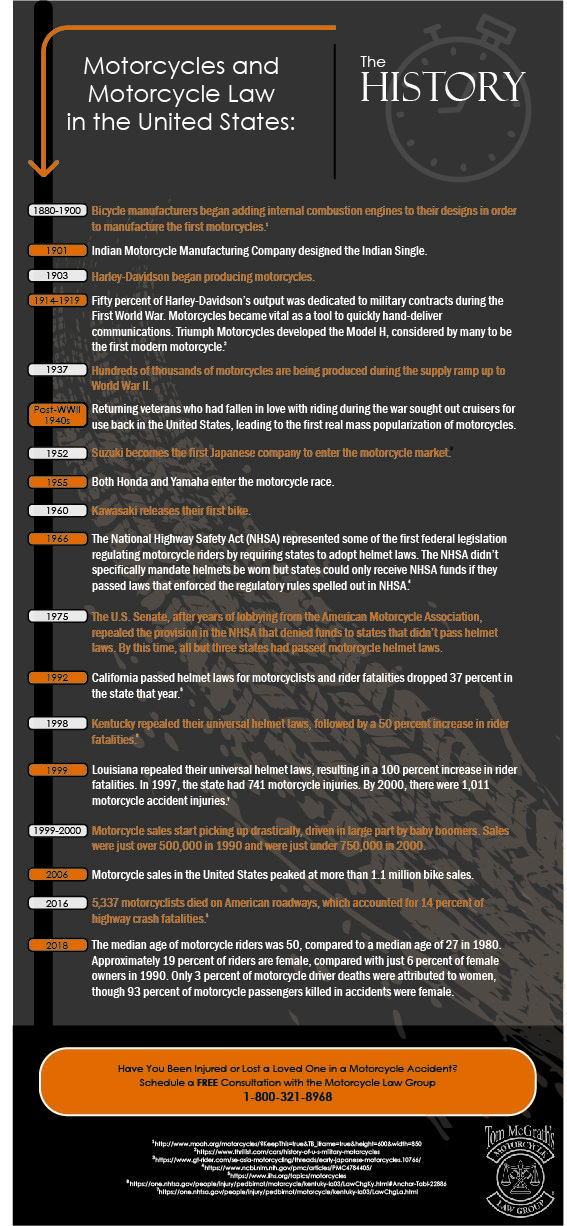Motorcycles have been a fixture in American culture since the end of World War II, when thousands of veterans who rode during wartime came home.
The second World War wasn’t the first time motorcycles had been used in war – in fact the U.S. military used motorcycles (Harley-Davidson’s to be specific) with sidecars during their hunt for Pancho Villa in 1916.
During World War I, half of Harley-Davidson’s bike output – approximately 20,000 – were sent oversees so commanders could quickly send messages via motorcycles.1
But it wasn’t until WWII when bikes became a huge part of the war effort. Harley-Davidson produced 70,000 WLAs, a military version of the popular civilian WL, overseas for use in both World War II and the Korean war.
Norton, a British motorcycle manufacturer, produced 100,000 of their WD16H bikes for the British Royal Army. BSA, another British bike manufacturer, produced 126,000 of their M20 models for use during WWII as well.
Motorcycle use wasn’t just popular among the allies. Companies like BMW were making motorcycles for the Germans. Sd.Kfz. produced the treaded motorcycles, referred to as “Rabbits” by the Allies, that you sometimes see in WWII movies.
Needless to say, there were a ton of bikes on Europe’s roads during that conflict. Lots of military veterans, especially scouts and message runners, missed at least one aspect of the war when they got home – riding.
The First Federal Attempt to Regulate Motorcycle Rider Safety
Some states had enacted universal motorcycle helmet and safety laws in the ‘50s and early ‘60s, but the first real federal legislation aimed at motorcycle safety took the form of the National Traffic and Motor Vehicle Safety Act of 1966 (NTMVSA). The law addressed several aspect of vehicle safety, including drunk driving laws targeted at underage drinking, early seat belt and child safety seat regulations and motorcycle helmet laws.2
The NTMVSA didn’t exactly force states to pass these laws, but it did offer states a bunch of federal money if they adopted the regulations recommended in the Act. Nearly every state fell in line.
By 1975, the only state that hadn’t passed laws requiring riders to wear helmets was California. That year congress repealed the NTMVSA’s motorcycle helmet provision due to pressure they received from lobbying organizations such as the American Motorcycle Association.
The National Highway Fatality and Injury Reduction Act of 1989 was the next attempt at federal regulation on motorcycle riders. It sought to reinstate the previous restriction on funds for failing to comply with federally recommended helmet laws. It proposed to withhold up to 10 percent of federal highway money from states that refused to adopt helmet laws.
Motorcycle lobbying organization succeeded in getting that 10 percent reduced to 3 percent by 1995.
Nearly every state currently has motorcycle helmet laws of some type. Illinois, Iowa and New Hampshire are the only three states that have no motorcycle helmet laws.3
More than half of states have limited helmet laws, such as those that only require helmets for riders under the age of 18 or 21.
- Virginia has had a universal helmet law since 1970.
- North Carolina adopted universal helmet legislation in 1968.
Work with Lawyers Experienced in Motorcycle Injury Cases
Motorcycle Law Group isthe law firm that rides –motorcycle injury cases are personal to us. We represent injured riders in Virginia and North Carolina. Our attorneys know state and local motorcycle laws and we know what riders face on the road daily because we are riders as well.
The results of your motorcycle injury case could be the difference between a lifetime of struggles or financial stability, especially if your injuries were severe and may prevent you from continuing to earn a living. When the stakes are high, our motorcycle lawyers are here to step up and fight for you.
Schedule a free consultation by calling us toll-free at(855) 529-7433.
